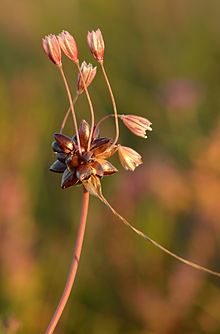| Field garlic | |
|---|---|

| |
| Scientific classification | |
| Kingdom: | Plantae |
| Clade: | Tracheophytes |
| Clade: | Angiosperms |
| Clade: | Monocots |
| Order: | Asparagales |
| Family: | Amaryllidaceae |
| Subfamily: | Allioideae |
| Genus: | Allium |
| Subgenus: | A. subg. Allium |
| Species: | A. oleraceum
|
| Binomial name | |
| Allium oleraceum L. 1753 not Des Moul. 1840
| |
| Synonyms[1] | |
|
Synonymy
| |
Allium oleraceum, the field garlic, is a Eurasian species of wild onion. It is a bulbous perennial that grows wild in dry places, reaching 30 centimetres (12 in) in height. It reproduces by seed, bulbs and by the production of small bulblets in the flower head (similarly to Allium vineale). Unlike A. vineale, it is very rare with A. oleraceum to find flower-heads containing bulbils only.[2] In addition, the spathe in A. oleraceum is in two parts.[2][3]
Its specific epithet oleraceum means "vegetable/herbal" in Latin and is a form of holeraceus (oleraceus).[4][5]
- ^ Kew World Checklist of Selected Plant Families
- ^ a b The Reader's Digest Field Guide to the Wild Flowers of Britain p.382.
- ^ Linnaeus, Carl von. 1753. Species Plantarum 1: 299.
- ^ Parker, Peter (2018). A Little Book of Latin for Gardeners. Little Brown Book Group. p. 328. ISBN 978-1-4087-0615-2.
oleraceus, holeraceus = relating to vegetables or kitchen garden
- ^ Whitney, William Dwight (1899). The Century Dictionary and Cyclopedia. Century Co. p. 2856.
L. holeraceus, prop. oleraceus, herb-like, holus, prop. olus (oler-), herbs, vegetables